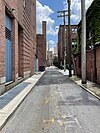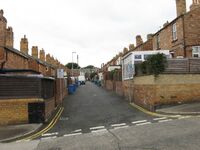Tag:service=alley
| Description |
|---|
| An alley is a service road usually located between properties for access to utilities. |
| Group: highways |
| Used on these elements |
| Requires |
| Status: de facto |
| Tools for this tag |
|
An alley or alleyway is a narrow highway=service road usually located between properties to provide access to back gardens, rear entrances, fire exits, and storage areas. Alleys are normally found in urban areas and often run between the rear sides of buildings such as houses and commercial premises.
In some regions, chiefly in Europe, narrow streets in historic cities that provide access to the main entrances of buildings may also be mapped as alleys, distinguishing them from wider modern streets mapped, for example, as highway=residential. In some areas, this case is much more common than the rear access case. In other regions[1][2] this is considered a form of tagging for the renderer and is discouraged. In these regions, local mappers are advised to use instead highway=residential along with the relevant width=* and lanes=* tags.
If a narrow street is prohibited for motor vehicles, consider using highway=pedestrian. If a narrow passage is prohibited for motor vehicles, consider using highway=footway.
Alley streets
Alley streets are a road classification found in Baltimore, Maryland, USA[3], and potentially other places. Alley streets are alleys by definition, i.e., they serve the rear of buildings, but are named. Most named alley streets have addresses assigned to them, often small homes or carriage-houses that have been converted into homes, due to Next Generation 911 (NG911) standards that require local governments to sign any public street with addresses. Alley streets may have sidewalks but they are small and designed to house trash cans or steps down from homes. Alley streets do not typically have on-street parking, which distinguishes them from residential streets.
| Tagging | Example |
|---|---|
| Ploy Street, alley street with a narrow sidewalk highway=service + service=alley + sidewalk=both + surface=asphalt |

|
| Teakle Alley, an alley street that looks like a standard alley with no sidewalk highway=service + service=alley + sidewalk=no + surface=concrete |

|
Examples
- United States
Bardes Alley, Cincinnati
Ira Alley, Cincinnati
Unnamed alley, Chicago
Unnamed alley, Minneapolis
Narrow historic streets
Very narrow old public streets which run between buildings in some historic settlements, such as medieval European cities, may be mapped using service=alley. These streets do not attract through traffic, although it is often legal. Detailing narrow streets by adding maxwidth=* (if signed) and width=* is highly recommended.
| Tagging | Example |
|---|---|
| Wide and legal highway=residential |
|
| Wide but illegal highway=pedestrian |
|
| Narrow, legal and possible for most vehicles highway=service + service=alley |
|
| Narrow and legal but possible only for small vehicles highway=* under discussion |
|
| Forbidden for vehicles highway=footway |
|
| Impossible (steps) highway=steps |
Usage
See also
- footway=alley – narrow footways for access to back gardens, rear entrances, fire exits, and storage areas where people can barely pass by
- Proposal:Alleyway - a proposal for alleys that are not covered by highway=service










